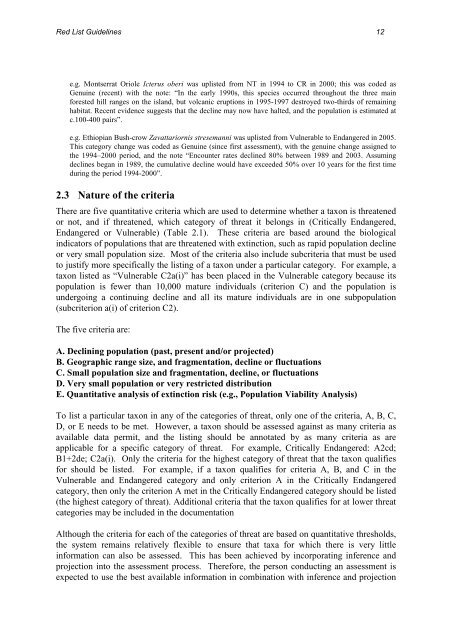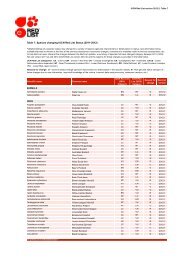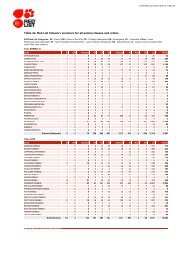IUCN Red List Guidelines - The IUCN Red List of Threatened Species
IUCN Red List Guidelines - The IUCN Red List of Threatened Species
IUCN Red List Guidelines - The IUCN Red List of Threatened Species
Create successful ePaper yourself
Turn your PDF publications into a flip-book with our unique Google optimized e-Paper software.
<strong>Red</strong> <strong>List</strong> <strong>Guidelines</strong> 12<br />
e.g. Montserrat Oriole Icterus oberi was uplisted from NT in 1994 to CR in 2000; this was coded as<br />
Genuine (recent) with the note: “In the early 1990s, this species occurred throughout the three main<br />
forested hill ranges on the island, but volcanic eruptions in 1995-1997 destroyed two-thirds <strong>of</strong> remaining<br />
habitat. Recent evidence suggests that the decline may now have halted, and the population is estimated at<br />
c.100-400 pairs”.<br />
e.g. Ethiopian Bush-crow Zavattariornis stresemanni was uplisted from Vulnerable to Endangered in 2005.<br />
This category change was coded as Genuine (since first assessment), with the genuine change assigned to<br />
the 1994–2000 period, and the note “Encounter rates declined 80% between 1989 and 2003. Assuming<br />
declines began in 1989, the cumulative decline would have exceeded 50% over 10 years for the first time<br />
during the period 1994-2000”.<br />
2.3 Nature <strong>of</strong> the criteria<br />
<strong>The</strong>re are five quantitative criteria which are used to determine whether a taxon is threatened<br />
or not, and if threatened, which category <strong>of</strong> threat it belongs in (Critically Endangered,<br />
Endangered or Vulnerable) (Table 2.1). <strong>The</strong>se criteria are based around the biological<br />
indicators <strong>of</strong> populations that are threatened with extinction, such as rapid population decline<br />
or very small population size. Most <strong>of</strong> the criteria also include subcriteria that must be used<br />
to justify more specifically the listing <strong>of</strong> a taxon under a particular category. For example, a<br />
taxon listed as “Vulnerable C2a(i)” has been placed in the Vulnerable category because its<br />
population is fewer than 10,000 mature individuals (criterion C) and the population is<br />
undergoing a continuing decline and all its mature individuals are in one subpopulation<br />
(subcriterion a(i) <strong>of</strong> criterion C2).<br />
<strong>The</strong> five criteria are:<br />
A. Declining population (past, present and/or projected)<br />
B. Geographic range size, and fragmentation, decline or fluctuations<br />
C. Small population size and fragmentation, decline, or fluctuations<br />
D. Very small population or very restricted distribution<br />
E. Quantitative analysis <strong>of</strong> extinction risk (e.g., Population Viability Analysis)<br />
To list a particular taxon in any <strong>of</strong> the categories <strong>of</strong> threat, only one <strong>of</strong> the criteria, A, B, C,<br />
D, or E needs to be met. However, a taxon should be assessed against as many criteria as<br />
available data permit, and the listing should be annotated by as many criteria as are<br />
applicable for a specific category <strong>of</strong> threat. For example, Critically Endangered: A2cd;<br />
B1+2de; C2a(i). Only the criteria for the highest category <strong>of</strong> threat that the taxon qualifies<br />
for should be listed. For example, if a taxon qualifies for criteria A, B, and C in the<br />
Vulnerable and Endangered category and only criterion A in the Critically Endangered<br />
category, then only the criterion A met in the Critically Endangered category should be listed<br />
(the highest category <strong>of</strong> threat). Additional criteria that the taxon qualifies for at lower threat<br />
categories may be included in the documentation<br />
Although the criteria for each <strong>of</strong> the categories <strong>of</strong> threat are based on quantitative thresholds,<br />
the system remains relatively flexible to ensure that taxa for which there is very little<br />
information can also be assessed. This has been achieved by incorporating inference and<br />
projection into the assessment process. <strong>The</strong>refore, the person conducting an assessment is<br />
expected to use the best available information in combination with inference and projection






